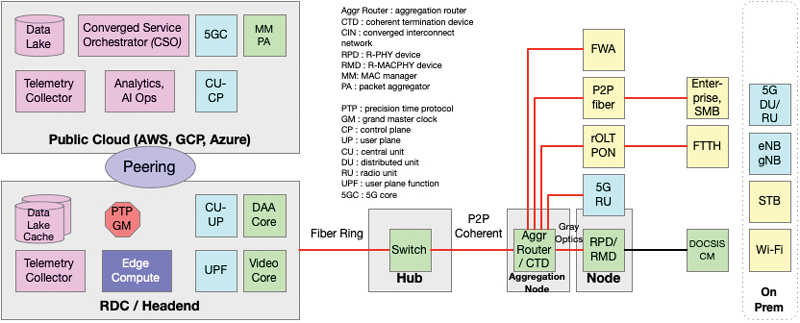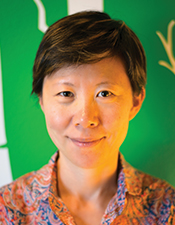A Framework for Convergence
By Dr. Jennifer Andreoli-Fang
For cable operators, mobile is the next frontier. It opens up a whole new market, that transcends traditional franchise boundaries — and with it, new sets of opportunities. Fun fact: About half of CableLabs members are mobile operators, and we expect that number to increase. (Table 1) [1].
Offering multiple wired and wireless services raises operational questions. Does it make sense to have two different teams for cable and mobile operations? Or two separate infrastructures, running services to the same customers? Counting traditional video networks, we’re up to three infrastructures. Would one be more cost efficient? These are the questions that lead to convergence.
The HFC evolution
Most of today’s plant exemplifies the traditional hybrid fiber/coax (HFC) network, and comprises analog nodes and analog fiber optics, along with integrated CMTS (I-CMTS) in the hub. How would the network evolve to handle mobile, and what about other network deployments like fixed wireless access and passive optical network (PON)? Can the network become all things to all people?
The answer is yes. The most recent modernization of the cable infrastructure came with the invention of remote PHY (R-PHY). R-PHY allows a traditional I-CMTS to be disaggregated, with only the modulator located in the node, and the software components of the I-CMTS relocated centrally. Disaggregation is the basis of virtualization, and a step towards cloud-native. R-PHY is now part of the distributed access architecture (DAA), along with the flexible MAC architecture (FMA).
R-PHY matters because it digitizes the connection between the hub and the node: analog fiber links become digital fiber networks. This digital fiber network is a crucial enabler of convergence.
Digital fiber networks also flatten the HFC plant, from that of a specialized application for providing cable broadband services, to a far more common IP-over-Ethernet connection. We now have IP to the neighborhood, and Ethernet to the home. This is really one of the fundamental changes that R-PHY brings to the table for mobile-converged services.
Converged fiber backhaul
The digital fiber transport can either be a DWDM collection of 10 Gbps wavelengths, or a 100 Gbps or higher speed coherent optics which is terminated by an aggregation router, also referred to as a coherent termination device (CTD). We now have a local set of 10 Gbps Ethernet connections that can be used to deploy different services.
The first service is the very DAA that drives the coax plant to deliver broadband to homes. Another is a fiber-to-the-home (FTTH) service with a PON overlay, achieved by plugging a remote optical line termination (rOLT) into the switch. The operator can connect enterprises or small businesses with point-to-point fiber off the same switch, in lieu of deploying separate IP networks. 5G deployments can also benefit from the same fiber network by connecting a 5G radio unit (RU) to a port. Finally, we can introduce fixed wireless access (FWA), a great opportunity for cable operators to extend rural footprints.
The digital fiber network that R-PHY enables provides a common fiber backhaul for residential, enterprise, FWA, and mobile services.
Mobile and cable convergence
Like cable, the mobile industry disaggregated its radio access network. The 5G equivalent of an I-CMTS is a gNB. The gNB is decomposed into an RU, a distributed unit (DU), and a central unit (CU). The CU is further separated by control (CU-CP) and user planes (CU-UP). RU and DU communicate via a fronthaul interface, and that fronthaul transport can be provided by the digital fiber network described previously. DUs and CUs are connected via a midhaul interface, while a CU is backhauled into a mobile core. The DOCSIS network can be reused to provide midhaul and backhaul services for 5G small cells, and potentially even fronthaul when using the recently proposed O-RAN 7-2x interface.
As 5G networks densify, DOCSIS networks provide an economic solution to connect tens or hundreds of small cells in a neighborhood without having to trench new fiber [2][4]. Convergence is happening over the access network with mobile traffic being transported over the HFC network, whether it is directly over dark fiber, or over coax with DOCSIS.
Convergence also positively impacts the headend. The 5G core (5GC) can sit adjacent to the CMTS core and legacy video core. No longer physical boxes, the CMTS core and 5GC are virtual, or rather, cloud-native software appliances. Cores no longer need dedicated compute, memory, and networking. As cloud-native functions, they can share common physical servers. This digital transformation plays another key role in convergence.
When rearchitecting the cable and mobile cores with cloud-native functions as a baseline, where should the software components be located: headend or cloud? Cable headends are often viewed as an optimal place for edge compute resources.
For example, the user plane, which includes 5G’s CU-UP and user plane function (UPF), can be placed at the headend. The 5GC or even HFC control plane components can be located either adjacent to the headend, or in a large-scale public cloud like AWS. Hybrid architectures allow an operator to take advantage of the cloud for its myriad of benefits, while leveraging their edge locations to provide appreciably low latency.
Service assurance and automation
Once a converged network is deployed, it needs to be configured and verified that it’s working. Any faults need to be continually fixed, preferably before they occur. This all falls into the category of service assurance. For all of this to be done, preferably without human intervention, we need automation.
Traditionally, configuration is done with a command line interface (CLI) and monitoring is done with SNMP. Today, each vendor sells a box with its proprietary CLI. Even with scripting, configuration by hand is time consuming and prone to user errors. SNMP polls can jam up CPUs and take down network equipment.
Modern service management is done with standardized YANG interfaces that automate configuration and monitoring via model driven telemetry (MDT). Instead of SNMP polls, YANG enables an MDT environment with a publish-and-subscribe model. Individual components can publish their statistics up to a collector which stores the data into a data lake. We can run analytics and AI on the data and find out what’s working. Once a fault is detected, decisions can be made autonomously to fix the faults. The key to operating a converged network is to get automation and telemetry right.
Opportunities and enablers
Mobile is a classic example of a new revenue stream that needs to happen without doubling the cost structure. The obvious opportunity here is to leverage the existing HFC plant. It already connects residences and businesses, and can also connect devices like small cells and IoT devices. Use the extant cable plant to connect everything. That’s the opportunity.
Migration to DAA creates the converged infrastructure. Bringing digital fiber to the neighborhood is an enabler. As we connect new services to the fiber and coax plant, additional technologies like Precision Time Protocol (PTP), DOCSIS Time Protocol (DTP) [5][6], and Low Latency Xhaul (LLX) [7][8] prep the network to match the new services.
Another obvious enabler is cloud technologies. Every industry is going through digital transformation. CMTSs and mobile cores were designed in monolithic boxes. They are being rearchitected into containerized software components to leverage the benefits of the cloud, like scalability and CI/CD (continuous integration, continuous delivery). Migration to the cloud needs automation to save on OpEx. The key enablers here are in the context of configuration and telemetry, which can be based on YANG. Modern digital infrastructure should be fully abstracted through a set of application programming interface (API) for orchestration and telemetry. The HFC components (routers, RPDs) need the same transformation. The network will become just a link that interconnects routers, RPDs, small cells. How would we deliver the HFC network as a service?
With software now being written as microservices, where would the workloads sit? On-premise, in a public cloud, or both? If public cloud, which one? That’s the concept of multicloud and hybrid cloud. Also: Cloud-only strategy, or cloud-first? These are the questions that our industry needs to sort out. That may be the subject of my next article.
Further Reading
[1] Jennifer Andreoli-Fang, et.al., “Cable and Mobile Convergence — a Vision from the Cable Communities Around the World,” SCTE Fall Technical Forum, Oct 2020.
[2] Jennifer Andreoli-Fang, “DOCSIS-Mobile Convergence,” Broadband Library, summer edition 2019.
[3] John T. Chapman, “HFC and 5G Backhaul – Two New Friends,” Broadband Library, Spring 2021.
[4] John T. Chapman, “Small Cell Traffic Engineering,” SCTE Cable-Tec Expo Fall Technical Forum, Denver, Oct, 2020.
[5] John T. Chapman, “The DOCSIS Timing Protocol (DTP) — Generating Precision Timing Services from a DOCSIS System,” SCTE Spring Expo, May 8, 2011.
[6] Synchronization Techniques for DOCSIS Technology Specification, CM-SP-SYNC-I02, 2021, Cable Television Laboratories, Inc.
[7] John T. Chapman and Jennifer Andreoli-Fang, “Mobile Backhaul over DOCSIS,” SCTE Fall Technical Forum, Oct, 2017.
[8] Low Latency Xhaul over DOCSIS Technology Specification, CM-SP-LLX-I02, 2020, Cable Television Laboratories, Inc.

Table 1. Mobile status of cable operators.

Dr. Jennifer Andreoli-Fang,
CableLabs
Dr. Jennifer Andreoli-Fang is a Distinguished Technologist at CableLabs. Jennifer led the development of DOCSIS 3.0, DOCSIS 3.1, and full duplex DOCSIS MAC specifications. She was a key leader in the development of unlicensed LTE and 5G NR technologies at the 3GPP and the Wi-Fi Alliance on the behalf of the cable industry. She co-invented Low Latency Xhaul (LLX) technology. Jennifer is currently working on cloud and heads the convergence architecture of mobile and cable broadband. Jennifer has more than 100 patents issued or pending, published more than 30 papers at the IEEE and SCTE, and is the winner of multiple innovation awards. She serves on the Technical Committee at the Facebook Telecom Infra Project (TIP).
Image: Shutterstock



